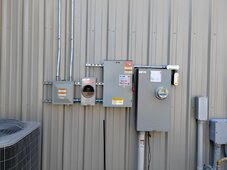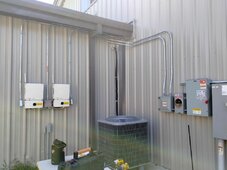The disconnect needs to be sized to the current load. Code requires this to be calculated at 125% of the max inverter production on the label (or the sum, for paralleled inverters).
For instance: 10k inverter is rated at 10000 watts, calculation says 12,500 watts. Divide that by 240V and you have 52A and change. In this case that would require a 60A disconnect and #6 copper wire or #4 aluminum wire.
There is another limitation: the lugs need to be the correct size for the wire that is being used. You cannot trim individual strands to get the wire to fit in cases where oversized wire was used for whatever reason, voltage drop or "it's all the supply house had." They make crimp on reducers for these purposes but that will almost always be a special order item and you will need the correct tool to crimp them on, which costs around $400 depending on the size. Sometimes you can bolt on larger chair lugs to the terminals in the disconnect. Be aware that inspectors have differing views on this kind of "field modification" of listed equipment.
I have many automatic questions about the sizing of your system. 4/0 aluminum is typically used in residential applications for a 200A circuit. In this case you will need a 200A disconnect, and the wire will fit in the lugs. Is there any means of overcurrent protection on this circuit from the power house? Does the wire travel underground to your residence? It may need to be a fused disconnect not a safety switch.
I'm hoping your grid tie (if you have one) is in the powerhouse and everything already has the proper service disconnect and load protection there, and is "passing through" so to speak to get to the residence. In that case all you need is a switch, no load protection.






